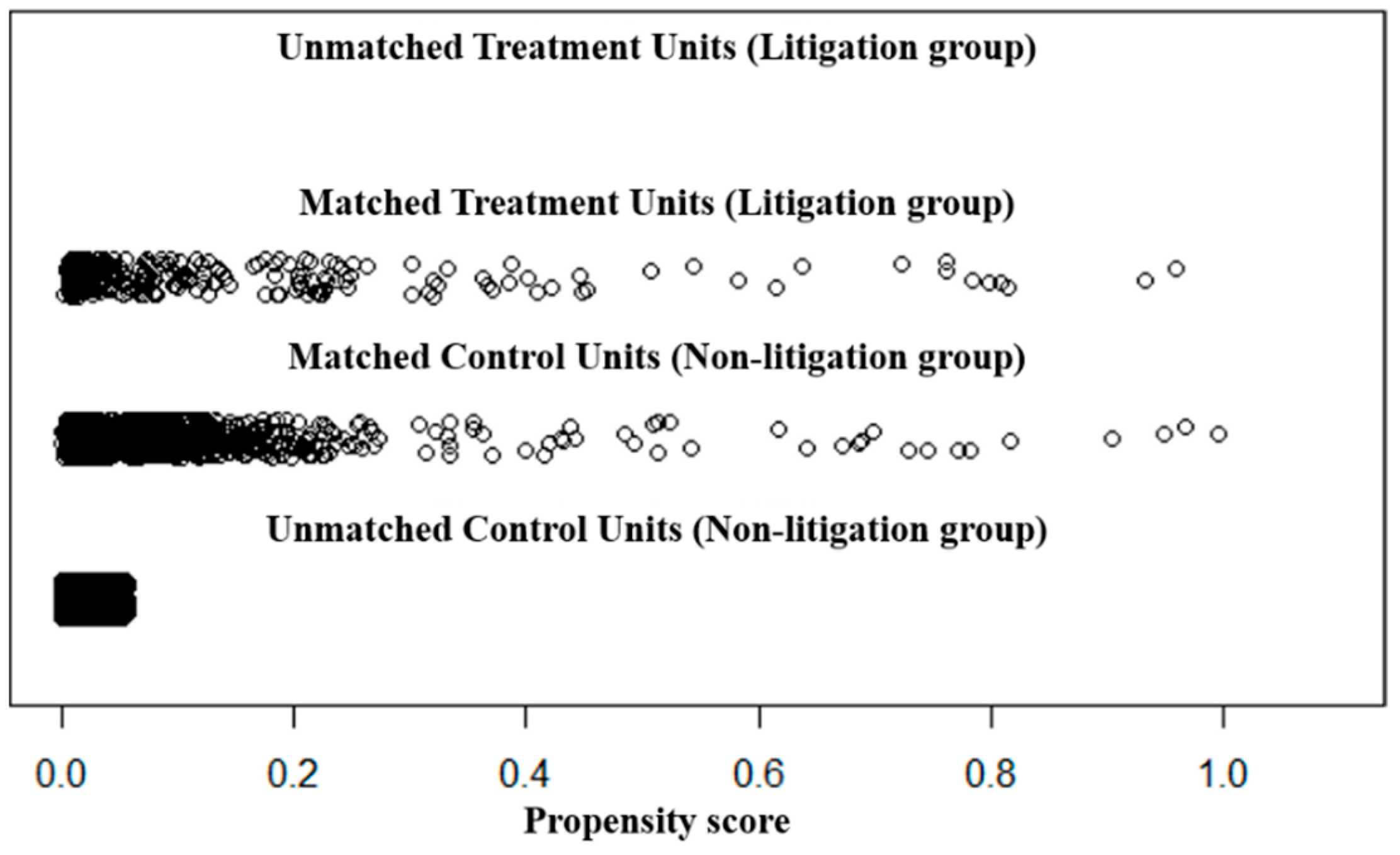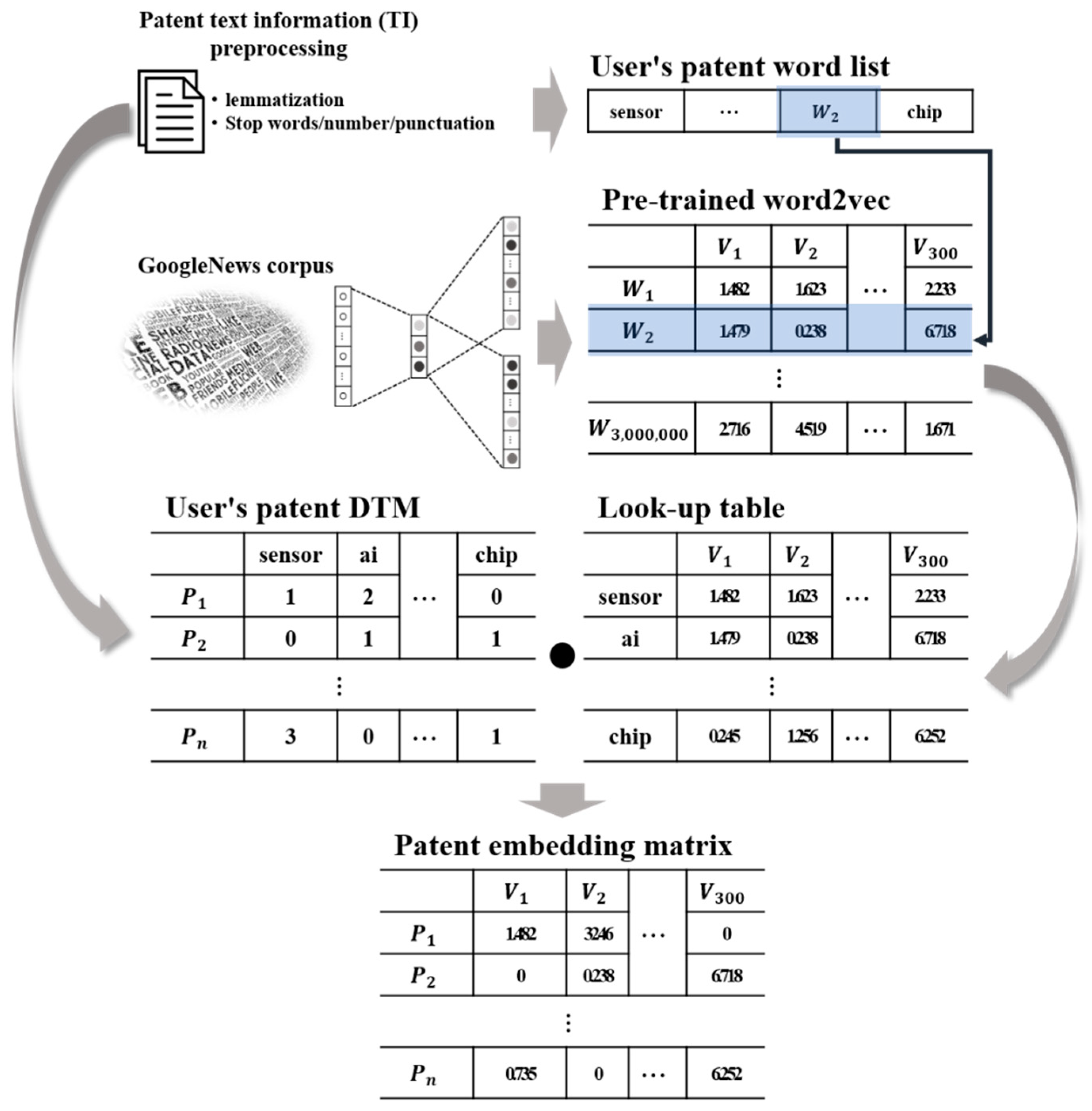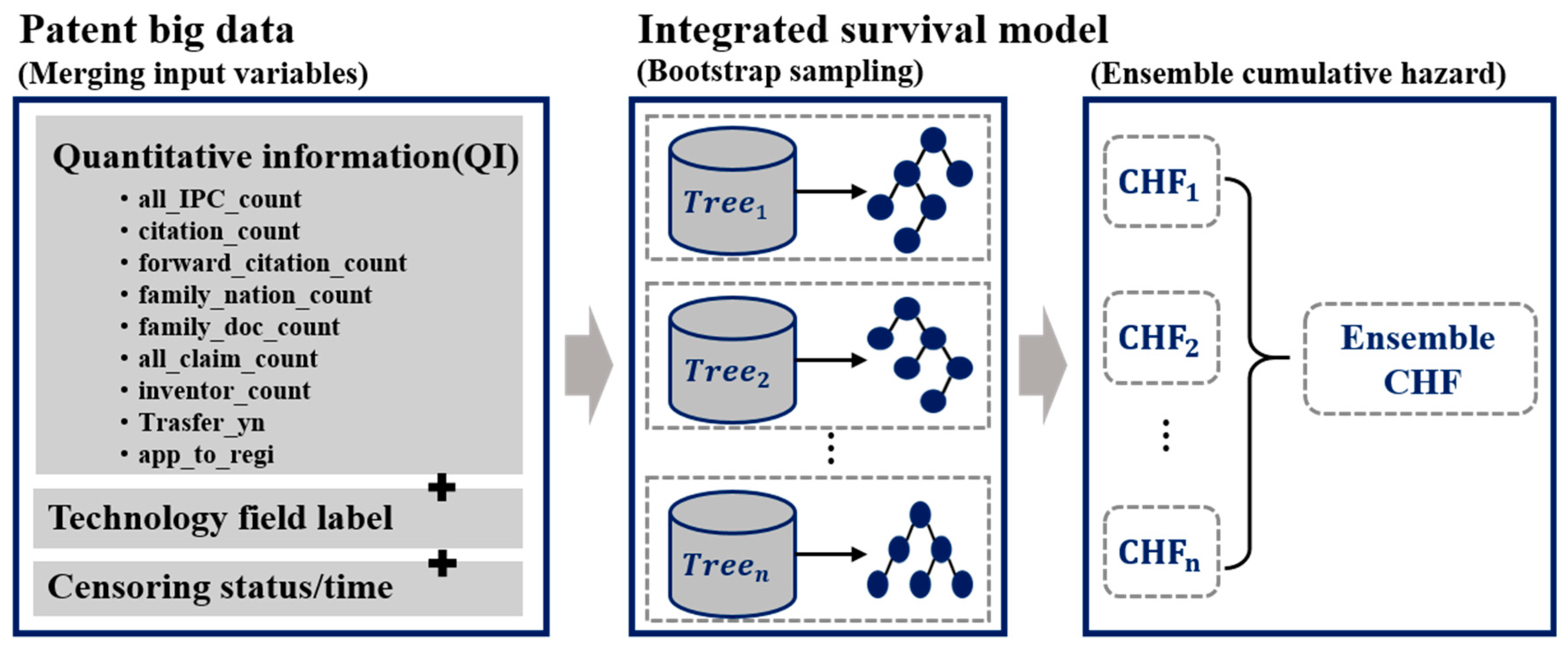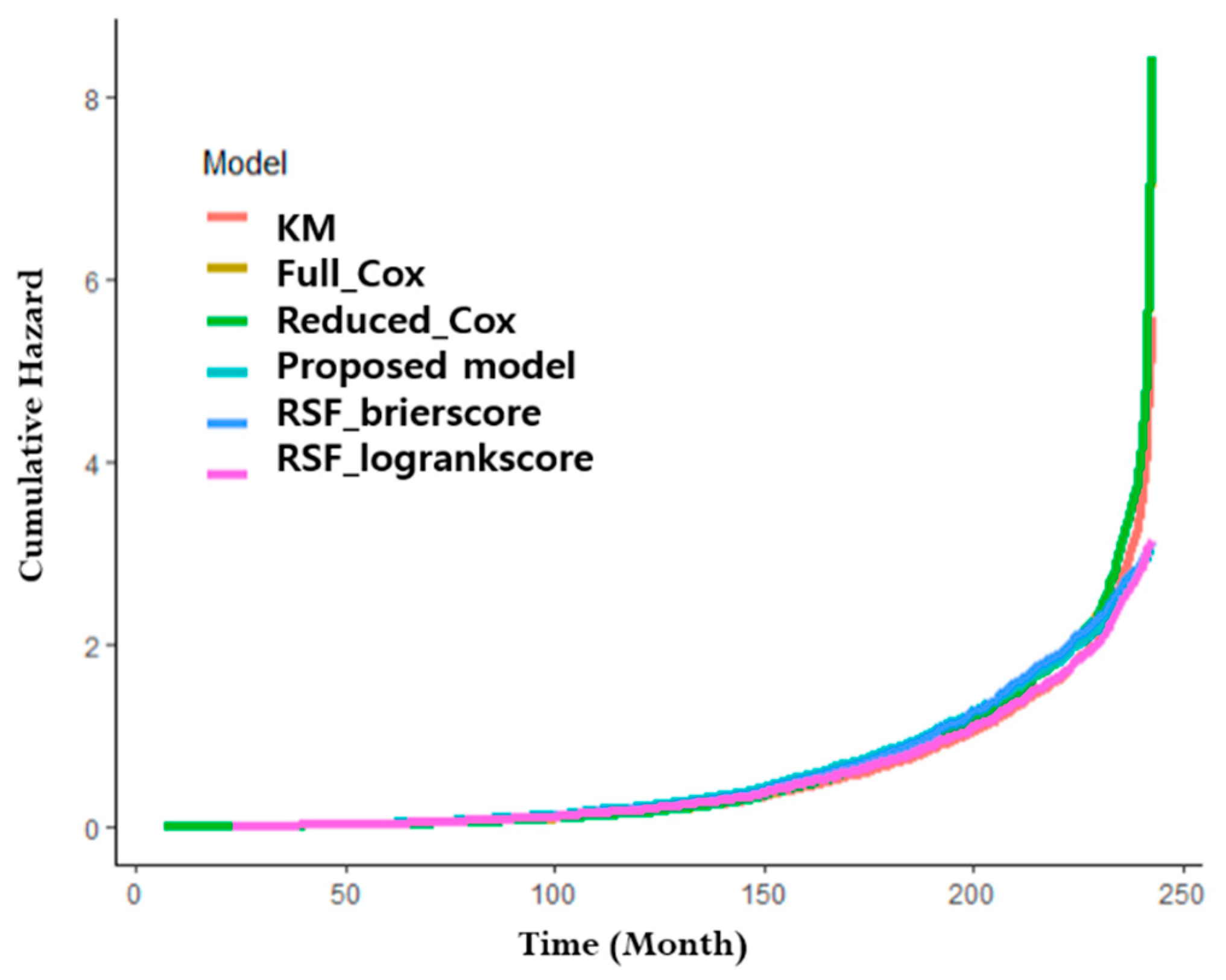Integrated Survival Model for Predicting Patent Litigation Hazard
Abstract
1. Introduction
2. Related Work
2.1. Quantitative Methods for Patent Litigation Analysis
2.2. Patent Survival Analysis
2.3. Random Survival Forest
3. Proposed Methodology
3.1. Data Description and Preprocessing
- : There is no difference in QI between the two groups.
- : There is a difference in QI between the two groups.
3.2. Patent Embedding and Technology Field Labeling
3.3. Patent Litigation Predictiong Model
4. Experiment Results
5. Discussion
6. Conclusions
Author Contributions
Funding
Institutional Review Board Statement
Informed Consent Statement
Data Availability Statement
Conflicts of Interest
References
- Eisenberg, R.S. Patents and the progress of science: Exclusive rights and experimental use. Univ. Chic. Law Rev. 1989, 56, 1017–1086. [Google Scholar] [CrossRef]
- Mogee, M.E. Using patent data for technology analysis and planning. Res. Technol. Manag. 2016, 34, 43–49. [Google Scholar] [CrossRef]
- Moro-Visconti, R. The Valuation of Digital Intangibles: Technology, Marketing and Internet; Palgrave Macmillan: London, UK, 2020; pp. 127–153. ISBN 978-3-030-36917-0. [Google Scholar]
- World Intellectual Property Organization. World Intellectual Property Indicators; WIPO: Geneva, GN, Switzerland, 2019; pp. 1–223. [Google Scholar]
- Casey, K.R. Alternate dispute resolution and patent law. Fed. Cir. B. J. 1993, 3, 1–14. [Google Scholar]
- Llobet, G. Patent litigation when innovation is cumulative. Int. J. Ind. Organ. 2003, 21, 1135–1157. [Google Scholar] [CrossRef]
- Bessen, J.; Meurer, M.J. Lessons for patent policy from empirical research on patent litigation. Lewis Clark L. Rev. 2005, 9, 1–28. [Google Scholar]
- Chien, C.V. Startups and patent trolls. Stanf. Technol. Law Rev. 2012, 17, 461–506. [Google Scholar] [CrossRef][Green Version]
- Graevenitz, G.V.; Wagner, S.; Harhoff, D. Incidence and growth of patent thickets: The impact of technological opportunities and complexity. J. Ind. Econ. 2013, 61, 521–563. [Google Scholar] [CrossRef]
- Lee, J. Essays on Market for Technology and Patent Strategy: Licensing, Patent Transaction, and Patent Litigation. Ph.D. Thesis, Korea Advanced Institute of Science and Technology, Daejeon, Korea, 2018. [Google Scholar]
- Yang, X.; Yu, X. Preventing Patent risks in artificial intelligence industry for sustainable development: A multi-level network analysis. Sustainability 2020, 12, 8667. [Google Scholar] [CrossRef]
- Lai, Y.; Che, H. Modeling patent legal value by extension neural network. Expert Syst. Appl. 2009, 36, 10520–10528. [Google Scholar] [CrossRef]
- Chien, C.V. Predicting patent litigation. Tex. Law Rev. 2011, 90, 283–329. [Google Scholar]
- Kim, A.; Partee, N.W.; Reynolds, T.; Santamaria, M.A.; Advisor, F.; Beling, P.; Ferron, D.V.; Winer, D.S.; Woolley, D.F. Patent litigation risk-scoring model. Available online: https://www.semanticscholar.org/paper/PATENT-LITIGATION-RISK-SCORING-MODEL-Kim-Partee/e634d98fc4759aff3c3409c2315a0297ec71e7bf (accessed on 12 November 2020).
- Lanjouw, J.O.; Schankerman, M. Characteristics of patent litigation: A window on competition. RAND J. Econ. 2001, 32, 129–151. [Google Scholar] [CrossRef]
- Bessen, J.; Meurer, M.J. The patent litigation explosion. Loy. U. Chi. L. J. 2013, 45, 401–440. [Google Scholar] [CrossRef][Green Version]
- Lee, J.; Kang, J.; Jun, S.; Lim, H.; Jang, D.; Park, S. Ensemble modeling for sustainable technology transfer. Sustainability 2018, 10, 2278. [Google Scholar] [CrossRef]
- Trappey, C.V.; Trappey, A.J.C.; Wu, C. Clustering patents using non-exhaustive overlaps. J. Syst. Sci. Syst. Eng. 2010, 19, 162–181. [Google Scholar] [CrossRef]
- Kim, C. A Study on Formulating Patent Litigation Forecasting Model and Method to Process Litigation Evaluation Factors. Ph.D. Thesis, Korea Advanced Institute of Science and Technology, Daejeon, Korea, 2014. [Google Scholar]
- Cowart, T.W.; Lirely, R.; Avery, S. Two Methodologies for Predicting Patent Litigation Outcomes: Logistic Regression Versus Classification Trees. Am. Bus. Law J. 2014, 51, 843–877. [Google Scholar] [CrossRef]
- Wongchaisuwat, P.; Klabjan, D.; McGinnis, J.O. Predicting litigation likelihood and time to litigation for patents. arXiv 2016, arXiv:1603.07394. [Google Scholar]
- Kartsonaki, C. Survival analysis. Diagn. Histopathol. 2016, 22, 263–270. [Google Scholar] [CrossRef]
- Rupert, G.M. Survival analysis. In Introduction to Survival Concepts; John Wiley & Sons: New York, NY, USA, 1998; pp. 1–9. [Google Scholar]
- Machin, D.; Cheung, Y.B.; Parmar, M. Survival analysis: A practical approach. In Introduction and Review of Statistical Concepts, 2nd ed.; John Wiley & Sons: Hoboken, NJ, USA, 2006; pp. 1–22. [Google Scholar]
- Guerzoni, M.; Nava, C.R.; Nuccio, M. The survival of start-ups in time of crisis. A machine learning approach to measure innovation. arXiv 2019, arXiv:1911.01073. [Google Scholar]
- Leung, K.; Elashoff, R.M.; Afifi, A.A. Censoring issues in survival analysis. Annu. Rev. Public Health 1997, 18, 83–104. [Google Scholar] [CrossRef]
- Wagner, S.; Cockburn, I. Patents and the survival of Internet-related IPOs. Res. Policy 2010, 39, 214–228. [Google Scholar] [CrossRef]
- Zeebroeck, N.V. Patents Only Live Twice: A Patent Survival Analysis in Europe. Available online: https://www.researchgate.net/publication/24131120_Patents_Only_Live_Twice_A_Patent_Survival_Analysis_in_Europe (accessed on 12 November 2020).
- Xie, Y.; Giles, D.E. A survival analysis of the approval of us patent applications. Appl. Econ. 2011, 43, 1375–1384. [Google Scholar] [CrossRef]
- Nikzad, R. Survival analysis of patents in canada. J. World Intellect. Prop. 2011, 14, 368–382. [Google Scholar] [CrossRef]
- Nakata, Y.; Zhang, X. A survival analysis of patent examination requests by japanese electrical and electronic manufacturers. Econ. Innov. New Technol. 2012, 21, 31–54. [Google Scholar] [CrossRef]
- Han, E.J.; Sohn, S.Y. Patent valuation based on text mining and survival analysis. J. Technol. Transf. 2015, 40, 821–839. [Google Scholar] [CrossRef]
- Erzurumlu, S.S.; Pachamanova, D. Topic modeling and technology forecasting for assessing the commercial viability of healthcare innovations. Technol. Forecast. Soc. Chang. 2020, 156, 120041. [Google Scholar] [CrossRef]
- Marco, A.C.; Miller, R.D. Patent Value and Uncertain Property Rights: Implications from Patent Litigation; Working papers Hoover IP2: Stanford, CA, USA, 2018; p. 18008. [Google Scholar]
- Ishwaran, H.; Kogalur, U.B.; Blackstone, E.H.; Lauer, M.S. Random survival forests. Ann. Appl. Stat. 2008, 2, 841–860. [Google Scholar] [CrossRef]
- Weathers, B.; Cutler, D.R. Comparison of Survival Curves between Cox Proportional Hazards, Random Survival Forest, and Conditional Inference Forests in Survival Analysis. Available online: https://digitalcommons.usu.edu/cgi/viewcontent.cgi?article=1936&context=gradreports (accessed on 12 November 2020).
- Breiman, L. Random forests. Mach. Learn. 2001, 45, 5–32. [Google Scholar] [CrossRef]
- Mikolov, T.; Chen, K.; Corrado, G.; Dean, J. Efficient estimation of word representations in vector space. arXiv 2013, arXiv:1301.3781. [Google Scholar]
- Rong, X. Word2vec parameter learning explained. arXiv 2016, arXiv:1411.2738. [Google Scholar]
- Rezaeinia, S.M.; Rahmani, R.; Ghodsi, A.; Veisi, H. Sentiment analysis based on improved pre-trained word embeddings. Expert Syst. Appl. 2019, 117, 139–147. [Google Scholar] [CrossRef]
- Google LLC. Word2vec. Available online: https://code.google.com/archive/p/word2vec/ (accessed on 12 November 2020).
- Sharma, A. A survey on different text clustering techniques for patent analysis. Int. J. Eng. Res. Technol. 2012, 1, 1–4. [Google Scholar]







| Technological Field | DB | Period | Status | Number of Patents (Number of Litigations) |
|---|---|---|---|---|
| Sensor semiconductor based on AI | USPTO | 1998~2020 | Registered | 14,198 (297) |
| Quantitative Information | Description | Measurable Value Information |
|---|---|---|
| all_IPC_count | Number of IPC codes | Technology scalability |
| citation_count | Number of backward citations | Technology impact |
| forward_citation_count | Number of forward citations | Technology impact |
| family_nation_count | Number of family nations | Market impact |
| family_doc_count | Number of family patents | Market impact |
| all_claim_count | Number of claims | Rights |
| inventor_count | Number of inventors | Sustainable development |
| transfer_yn | Technology transfer status (dummy) | Utility value |
| app_to_regi (days) | Time required from application to registration | Utility value |
| Variables | before PSM SD or n(%)) | after PSM SD or n(%)) | |||
|---|---|---|---|---|---|
| Litigation (n = 297) | Non-Litigation
(n = 13,901) | p-Value | Non-Litigation
(n = 1485) | p-Value | |
| all_IPC_count | 2.48 3.67 | 3.31 3.53 | <0.001 | 1.96 1.88 | 0.415 |
| citation_count | 75.59 117.46 | 40.89 138.39 | <0.001 | 76.54 326.41 | <0.001 |
| forward_citation_count | 77.37 108.1 | 21.04 43.03 | <0.001 | 58.17 92.94 | 0.002 |
| family_nation_count | 5.74 5.95 | 2.93 2.84 | <0.001 | 5.56 4.81 | 0.485 |
| family_doc_count | 73.29 171.31 | 22.4 138.37 | <0.001 | 68.35 240.30 | <0.001 |
| all_claim_count | 35.36 27.11 | 20.77 13.33 | <0.001 | 29.04 26.39 | <0.001 |
| inventor_count | 2.7 1.78 | 3.01 2.16 | 0.006 | 2.66 1.81 | 0.863 |
| transfer_yn | |||||
| Y | 162 (54.55%) | 3779 (27.19%) | <0.001 | 849 (57.17%) | 0.441 |
| N | 135 (45.46%) | 10,122 (72.82%) | 636 (42.83%) | ||
| app_to_regi (days) | 1189.94 675.14 | 1247.6 691.25 | 0.126 | 1311.81 680.38 | 0.002 |
| Model | Corpus Size (Words) | Number of Dimensions | Training Algorithm |
|---|---|---|---|
| GoogleNews-vectors-negative300 | 3,000,000 | 300 | Negative sampling |
| Components | Candidates |
|---|---|
| Splitting rule | Logrank |
| Number of trees | 1000 |
| Number of variables | 4 |
| Model | Description |
|---|---|
| KM | Kaplan-Meier Estimator |
| Full_Cox | CoxPH model with all variables |
| Reduced_Cox | CoxPH model with some variables by stepwise method |
| RSF_brierscore | RSF using Brier score as splitting rule |
| RSF_logrankscore | RSF using log rank score as splitting rule |
| Cluster (Technology Label) | Top Frequency Word List | Technology Field Definition |
|---|---|---|
| Cluster 1 (Tech 1) | signal, control, detect, plural | Object recognition technology |
| Cluster 2 (Tech 2) | Communic, receiv, network | Signal communication technology |
| Variable | Integrated Survival Model (Proposed Model) | RSF_brierscore | RSF_logrankscore |
|---|---|---|---|
| all_IPC_count | 0.0240 | 0.0147 | 0.0110 |
| citation_count | 0.0317 | 0.0301 | 0.0174 |
| forward_citation_count | 0.0215 | 0.0175 | 0.0183 |
| family_nation_count | 0.0096 | 0.0102 | 0.0102 |
| family_doc_count | 0.0142 | 0.0172 | 0.0178 |
| all_claim_count | 0.0180 | 0.0208 | 0.0185 |
| inventor_count | 0.0002 | 0.0008 | 0.0019 |
| transfer_yn | 0.0101 | 0.0081 | 0.0066 |
| app_to_regi | 0.0113 | 0.0150 | 0.0192 |
| Technology field label | 0.0007 | 0.0006 | 0.0012 |
| Variables | Full_Cox HR (95% CI) | Reduced_Cox HR (95% CI) |
|---|---|---|
| all_IPC_count | 1.18 (1.14–1.2) | 1.18 (1.14–1.2) |
| citation_count | 1.00 (1.00–1.0) | 1.00 (1.00–1.0) |
| forward_citation_count | 1.00 (1.00–1.0) | 1.00 (1.00–1.0) |
| family_nation_count | 1.03 (1.01–1.0) | 1.03 (1.02–1.0) |
| family_doc_count | 1.00 (1.00–1.0) | - |
| all_claim_count | 1.00 (1.00–1.0) | - |
| inventor_count | 0.97 (0.94–1.0) | 0.97 (0.94–1.0) |
| transfer_yn | ||
| Y | 1.37 (1.22–1.5) | 1.36 (1.21–1.5) |
| N | Reference | Reference |
| app_to_regi | 1.00 (1.00–1.0) | 1.00 (1.00–1.0) |
| Technology field label | ||
| Tech 1 | Reference | Reference |
| Tech 2 | 1.18 (1.04–1.3) | 1.18 (1.04–1.3) |
| Model | Prediction Error ( SD) | C-Index SD) |
|---|---|---|
| KM | 0.14 0.09 | 0.5 0.001 |
| Full_Cox | 0.13 0.08 | 0.72 0.16 |
| Reduced_Cox | 0.13 0.08 | 0.72 0.16 |
| Proposed model | 0.11 0.07 | 0.81 0.14 |
| RSF_brierscore | 0.12 0.07 | 0.8 0.14 |
| RSF_logrankscore | 0.12 0.08 | 0.81 0.15 |
Publisher’s Note: MDPI stays neutral with regard to jurisdictional claims in published maps and institutional affiliations. |
© 2021 by the authors. Licensee MDPI, Basel, Switzerland. This article is an open access article distributed under the terms and conditions of the Creative Commons Attribution (CC BY) license (http://creativecommons.org/licenses/by/4.0/).
Share and Cite
Kim, Y.; Park, S.; Lee, J.; Jang, D.; Kang, J. Integrated Survival Model for Predicting Patent Litigation Hazard. Sustainability 2021, 13, 1763. https://doi.org/10.3390/su13041763
Kim Y, Park S, Lee J, Jang D, Kang J. Integrated Survival Model for Predicting Patent Litigation Hazard. Sustainability. 2021; 13(4):1763. https://doi.org/10.3390/su13041763
Chicago/Turabian StyleKim, Youngho, Sangsung Park, Junseok Lee, Dongsik Jang, and Jiho Kang. 2021. "Integrated Survival Model for Predicting Patent Litigation Hazard" Sustainability 13, no. 4: 1763. https://doi.org/10.3390/su13041763
APA StyleKim, Y., Park, S., Lee, J., Jang, D., & Kang, J. (2021). Integrated Survival Model for Predicting Patent Litigation Hazard. Sustainability, 13(4), 1763. https://doi.org/10.3390/su13041763






